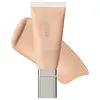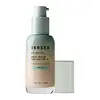Merit Beauty The Uniform Tinted Mineral Sunscreen SPF 45 Versus Versed Skin Solution Multi-Serum Skin Tint Foundation SPF 40
What's inside
What's inside
 Key Ingredients
Key Ingredients

 Benefits
Benefits

 Concerns
Concerns

No concerns
 Ingredients Side-by-side
Ingredients Side-by-side

Zinc Oxide
Cosmetic ColorantWater
Skin ConditioningPropanediol
SolventC13-15 Alkane
SolventIsoamyl Laurate
EmollientButyloctyl Salicylate
Skin ConditioningZea Mays Starch
AbsorbentPolyglyceryl-4 Diisostearate/Polyhydroxystearate/Sebacate
EmulsifyingC15-19 Alkane
SolventCoco-Caprylate
EmollientPolyhydroxystearic Acid
EmulsifyingMagnesium Sulfate
Diglycerin
HumectantCaprylic/Capric Triglyceride
MaskingQuaternium-90 Bentonite
Hydroxyacetophenone
AntioxidantDisteardimonium Hectorite
StabilisingLauroyl Lysine
Skin ConditioningTriethyl Citrate
MaskingCaprylyl Glycol
EmollientTocopheryl Acetate
AntioxidantSorbitan Isostearate
EmulsifyingCellulose
AbsorbentEthylhexylglycerin
Skin ConditioningPolyglycerin-3
HumectantPolyglycerin-4
HumectantGlycerin
HumectantTocopherol
AntioxidantCI 77891
Cosmetic ColorantCI 77491
Cosmetic ColorantCI 77492
Cosmetic ColorantCI 77499
Cosmetic ColorantZinc Oxide, Water, Propanediol, C13-15 Alkane, Isoamyl Laurate, Butyloctyl Salicylate, Zea Mays Starch, Polyglyceryl-4 Diisostearate/Polyhydroxystearate/Sebacate, C15-19 Alkane, Coco-Caprylate, Polyhydroxystearic Acid, Magnesium Sulfate, Diglycerin, Caprylic/Capric Triglyceride, Quaternium-90 Bentonite, Hydroxyacetophenone, Disteardimonium Hectorite, Lauroyl Lysine, Triethyl Citrate, Caprylyl Glycol, Tocopheryl Acetate, Sorbitan Isostearate, Cellulose, Ethylhexylglycerin, Polyglycerin-3, Polyglycerin-4, Glycerin, Tocopherol, CI 77891, CI 77491, CI 77492, CI 77499
Zinc Oxide 13.1%
Cosmetic ColorantWater
Skin ConditioningCoco-Caprylate/Caprate
EmollientC9-12 Alkane
SolventPropanediol
SolventButyloctyl Salicylate
Skin ConditioningGlycerin
HumectantPolyglyceryl-2 Dipolyhydroxystearate
Skin ConditioningC15-19 Alkane
SolventPolyglyceryl-4 Isostearate
EmulsifyingPolyhydroxystearic Acid
EmulsifyingMagnesium Sulfate
Tocopheryl Acetate
AntioxidantTerminalia Ferdinandiana Fruit Extract
AntioxidantJojoba Esters
EmollientHydrolyzed Sodium Hyaluronate
Skin ConditioningHydroxyacetophenone
AntioxidantTriheptanoin
Skin ConditioningTriethyl Citrate
MaskingPolyglyceryl-3 Polyricinoleate
EmulsifyingDilinoleic Acid/Butanediol Copolymer
Castor Oil/Ipdi Copolymer
Sorbitan Isostearate
EmulsifyingMica
Cosmetic ColorantDisteardimonium Hectorite
StabilisingQuaternium-90 Bentonite
Phenoxyethanol
PreservativeEthylhexylglycerin
Skin ConditioningTitanium Dioxide
Cosmetic ColorantIron Oxides
Zinc Oxide 13.1%, Water, Coco-Caprylate/Caprate, C9-12 Alkane, Propanediol, Butyloctyl Salicylate, Glycerin, Polyglyceryl-2 Dipolyhydroxystearate, C15-19 Alkane, Polyglyceryl-4 Isostearate, Polyhydroxystearic Acid, Magnesium Sulfate, Tocopheryl Acetate, Terminalia Ferdinandiana Fruit Extract, Jojoba Esters, Hydrolyzed Sodium Hyaluronate, Hydroxyacetophenone, Triheptanoin, Triethyl Citrate, Polyglyceryl-3 Polyricinoleate, Dilinoleic Acid/Butanediol Copolymer, Castor Oil/Ipdi Copolymer, Sorbitan Isostearate, Mica, Disteardimonium Hectorite, Quaternium-90 Bentonite, Phenoxyethanol, Ethylhexylglycerin, Titanium Dioxide, Iron Oxides
Ingredients Explained
These ingredients are found in both products.
Ingredients higher up in an ingredient list are typically present in a larger amount.
Butyloctyl Salicylate is a chemical UV filter structurally similar to octisalate. It is a photostabilizer, SPF booster, emollient and solvent. This ingredient helps evenly spread out ingredients.
According to a manufacturer, it is suitable for pairing with micro Titanium Dioxide, Zinc Oxide, and pigments.
Photostabilizers help stabilize UV-filters and prevents them from degrading quickly.
Learn more about Butyloctyl SalicylateC15-19 alkane is a mixture of alkanes. Alkanes are hydrocarbons with carbon atoms held together by single bonds.
It is a synthetically created solvent and emollient often used to replace silicones or mineral oil. As an emollient, C15-19 Alkane helps soften and soothe the skin. Emollients create a barrier to trap moisture inside.
C15-19 Alkane is often used with mineral UV filters such as titanium dioxidide and zinc oxide. It helps these UV filter ingredients be more spreadable.
C15-19 Alkane is biodegradable.
Learn more about C15-19 AlkaneDisteardimonium Hectorite comes from the clay mineral named hectorite. It is used to add thickness to a product.
It can also help stabilize a product by helping to disperse other ingredients.
Hectorite is a rare, white clay mineral.
Learn more about Disteardimonium HectoriteEthylhexylglycerin (we can't pronounce this either) is commonly used as a preservative and skin softener. It is derived from glyceryl.
You might see Ethylhexylglycerin often paired with other preservatives such as phenoxyethanol. Ethylhexylglycerin has been found to increase the effectiveness of these other preservatives.
Glycerin is already naturally found in your skin. It helps moisturize and protect your skin.
A study from 2016 found glycerin to be more effective as a humectant than AHAs and hyaluronic acid.
As a humectant, it helps the skin stay hydrated by pulling moisture to your skin. The low molecular weight of glycerin allows it to pull moisture into the deeper layers of your skin.
Hydrated skin improves your skin barrier; Your skin barrier helps protect against irritants and bacteria.
Glycerin has also been found to have antimicrobial and antiviral properties. Due to these properties, glycerin is often used in wound and burn treatments.
In cosmetics, glycerin is usually derived from plants such as soybean or palm. However, it can also be sourced from animals, such as tallow or animal fat.
This ingredient is organic, colorless, odorless, and non-toxic.
Glycerin is the name for this ingredient in American English. British English uses Glycerol/Glycerine.
Learn more about GlycerinHydroxyacetophenone is antioxidant with skin conditioning and soothing properties. It also boosts the efficiency of preservatives.
This ingredient is not irritating or sensitizing.
Magnesium Sulfate is a salt. More specifically, it is an epsom salt, or the bath salt used to help relieve muscle aches.
Despite having ‘sulfate’ in the name, it isn’t a surfactant or cleansing agent like sodium lauryl sulfate. Unlike those sulfates, magnesium sulfate doesn’t have the same cleansing or foaming properties (it's simply a type of salt).
In cosmetics, Magnesium Sulfate is used to thicken a product or help dilute other solids. It is a non-reactive and non-irritating ingredient.
One study shows magnesium deficiency may lead to inflammation of the skin. Applying magnesium topically may help reduce inflammation.
You can find this ingredient in sea water or mineral deposits.
Learn more about Magnesium SulfatePolyhydroxystearic Acid is a soft wax made from castor oil.
It is is a texture thickener, emulsifier, and film-former. Emulsifiers prevent ingredients from separating, such as oils and waters.
Polyhydroxystearic Acid may not be fungal acne safe.
Learn more about Polyhydroxystearic AcidPropanediol is an all-star ingredient. It softens, hydrates, and smooths the skin.
It’s often used to:
Propanediol is not likely to cause sensitivity and considered safe to use. It is derived from corn or petroleum with a clear color and no scent.
Learn more about PropanediolWe don't have a description for Quaternium-90 Bentonite yet.
Sorbitan Isostearate is an emulsifer and cleaning agent. It is created from isostearic acid and sorbitol.
As an emulsifier, Sorbitan Isostearate prevents oils and water from separating.
Due to its isostearic acid base, it may not be safe for Malassezia or fungal acne.
Learn more about Sorbitan IsostearateTocopheryl Acetate is AKA Vitamin E. It is an antioxidant and protects your skin from free radicals. Free radicals damage the skin by breaking down collagen.
One study found using Tocopheryl Acetate with Vitamin C decreased the number of sunburned cells.
Tocopheryl Acetate is commonly found in both skincare and dietary supplements.
Learn more about Tocopheryl AcetateTriethyl Citrate comes from citric acid. It has masking, perfuming, and solvent properties. As a solvent, this ingredient helps disperse ingredients evenly in skincare.
One manufacturer claims this ingredient can:
According to perfume manufacturers, this ingredient is almost odorless but has a mild fruity, wine and plum scent. It can be used to mask the scent of other ingredients.
This ingredient can be plant-sourced or synthetic; it can naturally be found in cabbage and white wine.
Learn more about Triethyl CitrateWater. It's the most common cosmetic ingredient of all. You'll usually see it at the top of ingredient lists, meaning that it makes up the largest part of the product.
So why is it so popular? Water most often acts as a solvent - this means that it helps dissolve other ingredients into the formulation.
You'll also recognize water as that liquid we all need to stay alive. If you see this, drink a glass of water. Stay hydrated!
Learn more about WaterZinc Oxide is a mineral broad-spectrum UV filter; it is the broadest UVA and UVB reflector approved by the FDA. It also has skin protectant and skin soothing properties.
Zinc oxide is one of the most effective broad-spectrum UV filters. It protects against UVB, UVAII, and UVAI. In comparison to its counterpart titanium dioxide, zinc oxide provides uniform and extended UVA protection.
Another great benefit? This ingredient is highly photostable so it won't degrade easily under sunlight.
A common myth is that mineral UV filters are widely believed to primarily reflect UV light.
However, modern research shows titanium dioxide absorbs UV radiation like chemical filters (~95% absorption & 5% reflection).
Zinc oxide has great skin soothing properties so you'll likely find this in sunscreens formulated for sensitive skin or babies/children. It is unlikely to cause "eye sting" like other sunscreen ingredients.
Regulatory agencies consider zinc oxide to be non-toxic and safe. It has also been shown to not penetrate the skin.
Unfortunately, this ingredient does leave a visible white cast. This is why mineral sunscreens are often less cosmetically elegant than chemical or hybrid ones.
In cosmetics, zinc oxide can be found in both non-nano and nano-sized forms. The nano version is used to reduce white cast and improve the texture of sunscreen formulas.
There are ongoing concerns surrounding nano-zinc oxide's impact on marine ecosystems and whether it can be absorbed into skin.
Regarding marine ecosystems and coral reefs, there is no conclusive evidence that any form of zinc oxide (or any other sunscreen ingredients) will cause harm. The science is still developing but many consumers are keeping a close eye on this issue.
Please note, many destinations have reef-safety sunscreen rules. For instance, the U.S. Virgin Islands advises all visitors to use non-nano mineral sunscreens.
There has also been some stir about whether micronized or nano zinc oxide has potential photoxicity and absorption through the skin/lungs.
An in-vitro (done in a test tube or petri dish) study demonstrated micronized zinc oxide to have potential phototoxicity. There's no need to fret; the EU Commission's Scientific Committee on Consumer Safety has stated, "The relevance of these findings needs to be clarified by appropriate investigations in vivo." Or in other words, further studies done on living organisms are needed to prove this.
Current research shows zinc oxide nanoparticles do not penetrate intact or sunburned skin. They either remain on the surface or in the outermost layer of dead skin (stratum corneum).
Zinc oxide is one of only two classified mineral UV filters with titanium dioxide being the other one.
Fun fact: Zinc has been used throughout history as an ingredient in paint and medicine. An Indian text from 500BC is believed to list zinc oxide as a salve for open wound. The Ancient Greek physician Dioscorides has also mentioned the use of zinc as an ointment in 1AD.
Learn more about Zinc Oxide